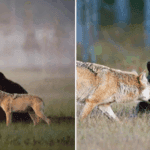In recent years, a powerful scientific tool has revolutionized the way law enforcement solves long-unsolved cases involving abandoned newborns. Genetic genealogy, a technique that combines DNA analysis with traditional genealogical research, is not only identifying the mothers who left their infants behind but also shedding light on tragic stories that have remained mysteries for decades. This breakthrough is reshaping cold case investigations and bringing justice to victims and their families.
The Sioux Falls Case: A Turning Point in DNA Investigation
One of the most striking examples of this technology’s impact is the case of a newborn boy found in a ditch near Sioux Falls, South Dakota, in 1981. Wrapped in a blanket and exposed to freezing temperatures, the infant—later named Andrew John Doe—had been born alive but died from exposure. For nearly 40 years, his identity and the circumstances of his death remained unknown.
In 2009, investigators exhumed the infant’s remains to obtain DNA, but initial database searches yielded no matches. The breakthrough came after the 2018 arrest of the infamous “Golden State Killer,” the first public case solved through genetic genealogy. Inspired by this success, Sioux Falls detectives partnered with Parabon NanoLabs, a leader in forensic genetic genealogy, to build a family tree from Andrew John Doe’s DNA. By cross-referencing historical records and genealogical data, they identified Theresa Bentaas as the infant’s mother. She was arrested in 2025 and charged with multiple counts, including first-degree murder. The father, also a teenager at the time, was interviewed but not charged, as he was unaware of the pregnancy.
Detective Michael Webb credited the case’s resolution to a blend of “sheer determination and stubbornness coupled with science and DNA and genealogy,” underscoring how new advancements are continually unlocking answers once thought impossible.
The Science Behind Genetic Genealogy
Genetic genealogy works by comparing DNA from unidentified victims or suspects with genetic profiles voluntarily submitted to public databases by individuals researching their ancestry. When a partial match is found, genealogists construct family trees to identify potential relatives, narrowing down the search for unknown persons. This method has proven especially effective in cases where traditional investigative leads have dried up.
The technique gained prominence with the Golden State Killer case, but since then, it has been applied to a wide range of cold cases, including abandoned newborns, unidentified bodies, and decades-old murders. Parabon NanoLabs and other forensic genealogy teams have helped solve dozens of cases by combining DNA sequencing with archival research and social media analysis.
Other Notable Cases of Abandoned Newborns Identified Through DNA
The Sioux Falls case is part of a growing list of cold cases solved through genetic genealogy, highlighting the broader impact of this technology.
Baby Alpha Beta: From Abandonment to Family Reunion
In 1987, a newborn dubbed “Baby Alpha Beta” was abandoned at a supermarket in Orange County, California. Despite a mild case of hypothermia, the baby was healthy and placed in foster care. Years later, genealogist CeCe Moore used consumer DNA testing services and archival research to trace the infant’s birth mother and siblings, reuniting the family after 27 years. While this case was not initially a criminal investigation, it demonstrated the power of genetic genealogy to restore identities and families.
Angel Baby Doe: A Cold Case Solved After Two Decades
In North Texas, a newborn girl found abandoned on the side of a road in 2001 was known as “Angel Baby Doe.” The infant was wrapped in a jacket with her umbilical cord still attached, indicating she was born alive outside a medical facility. For over 20 years, the case remained unsolved despite numerous interviews and DNA samples. In 2021, investigators submitted forensic evidence to Othram, a company specializing in forensic genome sequencing. Their work led to new leads, and in 2023, DNA tests identified Shelby Stotts as the biological mother, who is now implicated in abandoning the child.
Baby Garnet: Identification Through Forensic Genealogy
In Michigan’s Upper Peninsula, Baby Garnet was discovered in 1997 in a campground waste pit. For years, the infant’s identity remained a mystery. It was only through forensic genealogy that investigators finally identified the child, providing closure to a decades-old case.
Baby Theresa: Wisconsin’s Abandoned Newborn Case
In 2009, a newborn named Baby Theresa was found tied up in a garbage bag near Theresa, Wisconsin. DNA analysis eventually identified her biological mother, Karin Luttinen, who received probation after pleading guilty to concealing the death of a child. The case highlighted how DNA evidence can clarify the circumstances surrounding abandoned infants and the legal consequences for those involved.
Read more: Terence Tao Has an IQ of 230. He’s Officially Been Recognized As The Smartest Person In The World
Genetic Genealogy’s Role in Solving Other Cold Cases
Beyond abandoned newborns, genetic genealogy has been instrumental in resolving numerous cold cases involving murders and disappearances.
- In Sacramento, the 1970 murder of court reporter Nancy Marie Bennallack was solved in 2022 when investigators identified the killer through DNA genealogy, bringing closure after more than 50 years.
- The 1972 murder of Jody Loomis was linked to a suspect through DNA evidence preserved on her clothing, leading to an arrest decades later.
- California cold cases involving sexual assault and murder from the late 1980s were connected to a suspect identified through genetic genealogy, although the suspect died before trial.
- In Vermont, the 1989 double homicide of an elderly couple was solved when forensic tests linked the crime to a family member, resulting in an arrest in 2022.
These examples underscore how genetic genealogy is reshaping law enforcement’s ability to solve cases that once seemed impossible.
Ethical Considerations and Public Involvement
While genetic genealogy has proven invaluable, it raises important ethical questions about privacy and consent. Individuals who submit their DNA to public ancestry databases may unknowingly assist law enforcement in investigations involving distant relatives. Agencies generally follow strict protocols and obtain legal authorization before accessing DNA samples from suspects.
Public interest and support have played a role in advancing these investigations. In Minnesota, community donations helped fund DNA testing that solved cold cases involving abandoned newborns, demonstrating societal commitment to justice.
The Future of Cold Case Investigations
The success of genetic genealogy in cases like Andrew John Doe’s arrest signals a new era in forensic science. As DNA sequencing technology becomes more accessible and genealogical databases grow, more cold cases involving vulnerable victims—especially abandoned newborns—are likely to be solved.
Detective Webb’s reflection captures this momentum: “Science and determination are unlocking answers that were once thought impossible. The advancements in DNA and genealogy are transforming justice for victims and their families.” With each solved case, families receive long-awaited closure, and communities see justice served, even decades later.
Read more: You Can Now Adopt Puppies That Were ‘Too Friendly’ To Become Police Dogs
Conclusion
The application of genetic genealogy has transformed the landscape of cold case investigations, particularly those involving abandoned newborns. From Sioux Falls to Texas, Michigan, and beyond, DNA technology is revealing hidden truths and holding individuals accountable for past actions. As this powerful tool continues to evolve, it promises to bring justice to many more victims and their families, proving that no case is truly beyond resolution.










